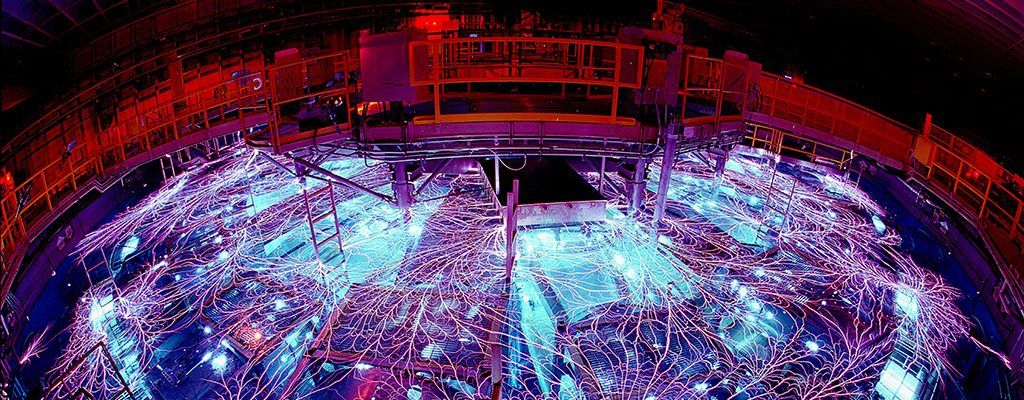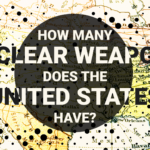Nuclear weapons: The death of fusion?
By Daniel Clery | July 17, 2013
 The “Z machine” at Sandia measures the velocities of shocks and surface motions when enormous pressures are applied to target materials in high-energy density science experiments. Such data inform fundamental studies of materials at extreme conditions and provide insight into the hydrodynamics of inertial confinement fusion targets. Image courtesy of Randy Montoya, Sandia National Laboratories
The “Z machine” at Sandia measures the velocities of shocks and surface motions when enormous pressures are applied to target materials in high-energy density science experiments. Such data inform fundamental studies of materials at extreme conditions and provide insight into the hydrodynamics of inertial confinement fusion targets. Image courtesy of Randy Montoya, Sandia National Laboratories
Fusion energy has, since its earliest days, had an uncomfortable relationship with the military. The idea that you could produce energy by fusing atoms grew out of efforts to understand how the Sun and stars manage to pump out such prodigious quantities of energy for billions of years without flagging. It was an entirely academic pursuit in the 1920s and 30s, but then World War II intervened.
As soon as weapons designers realized that they could upgrade an atom bomb to a more powerful hydrogen bomb by adding fusion to the mix, they became fascinated by the possibilities. Even non-explosive magnetic confinement fusion interested weapons designers as a potential source of high-energy neutrons for creating fissile materials. As a result, fusion researchers toiled for many years in secret. Today, research on inertial confinement fusion—the other leading approach—remains largely under the control of US national weapons labs. The military focus has had profound impacts on the development of inertial fusion energy.
The quest for a super bomb. The wartime Manhattan Project bypassed fusion in favour of fission; splitting uranium or plutonium was much easier and conveniently produced a runaway chain reaction. But one of the Los Alamos scientists, Edward Teller, believed that the project should develop a much more powerful fusion weapon in parallel. His colleagues disagreed, but so firm was Teller’s conviction that he often ignored the work assigned to him so that he could continue developing the fusion weapon, or “Super,” on his own.
After the war, Teller again urged his Los Alamos colleagues to move straight on to developing the Super. But having seen the effects of the two bombs dropped on Japan, few of Teller’s colleagues had any desire to build something even more devastating. The Los Alamos physicists began looking into the possibility of controlled nuclear fusion as an energy source but dropped the subject as the Manhattan Project began to disband.
University-based scientists then took up the mantle, at Oxford University and Imperial College London in the United Kingdom and Princeton University in the United States. But the research didn’t remain out in the open for long. As soon as it became obvious that a fusion reactor would produce large quantities of high-energy neutrons, military labs became interested again. The military needed neutrons because, at that time, there was not much fissile material around for building bombs—and neutrons can convert non-fissile isotopes into fissile ones. The British fusion researchers became part of the government’s Atomic Energy Research Establishment, while the Princeton effort was subsumed into Project Matterhorn, part of the US program to develop the Super—which would use a fission bomb to compress and ignite fusion fuel—these days known as a hydrogen bomb.
Fusion researchers toiled in secret government laboratories for years, unable to publish their results in journals, discuss problems with colleagues, or even tell their families what they were doing. This inability to consult with specialists in related fields, who might have brought a fresh perspective to technical problems, slowed progress.
By the mid-1950s new sources of uranium had been found and the need for neutrons became less pressing, but governments were loath to relinquish their control over fusion. In 1953, President Dwight Eisenhower pledged to make nuclear technology available for the benefit of mankind. Fission research was unveiled at a 1955 conference in Geneva, but governments held onto fusion for another three years. In January 1958, Britain revealed its ZETA reactor, which researchers believed had made a major breakthrough toward practical fusion energy. The breakthrough turned out to be illusory, but fusion was now public property and the US, UK, and Russian governments completely declassified the field at another Geneva conference later that year.
Shrinking the bomb. The type of fusion known at that time, which uses magnetic fields to contain superhot hydrogen gas and is known as magnetic confinement fusion, remained relatively free of government restriction after 1958. But that was not the case for inertial confinement fusion, a rival technology that seeks to crush a tiny capsule of nuclear fuel with powerful lasers until it ignites—a hydrogen bomb in miniature.
Inertial fusion grew directly out of the US H-bomb effort. After the first H-bomb test in 1952, weapons scientists worked feverishly to design devices that were smaller, more stable, and more powerful. H-bombs are actually two bombs in one, because a fission atomic bomb is used to create the conditions that are needed to ignite the fusion fuel. In the late 1950s, researchers at the Lawrence Livermore National Laboratory began to look around for other ways to spark the fusion explosion. One of these weapons designers, John Nuckolls, theorized that with a suitable spark you could make fusion bombs very small—small enough for the blast to be contained in a chamber so that its energy could be captured and used to generate electricity. The only problem was that the researchers didn’t have a spark that could ignite a tiny fusion bomb.
The demonstration of a working laser in 1960 changed all that. By the end of the decade it was possible to make lasers powerful enough to implode tiny spherical pellets containing fusion fuel. But the Livermore lab and its paymaster, the Atomic Energy Commission (AEC), kept a tight lid on inertial fusion because it was based on ideas similar to those used to make H-bombs. The AEC’s obsession with secrecy was so great that when a private company called KMS Industries tried to patent the idea of laser-based inertial fusion, which it had arrived at independently, the AEC banned KMS Industries from doing any more work on fusion. KMS’s main scientist was forbidden to talk about his ideas, carry out any simulations, or even write anything down on paper. The AEC eventually relented and allowed KMS to continue work, but while the research had to remain classified and under government control, KMS was not allowed to receive any government funding or have access to Livermore’s research results, and could not hire any former AEC employees.
Stockpile stewardship calls the shots. Unlike magnetic confinement fusion, inertial fusion has never been able to shake off its connection to the military. Most research continues to be carried out in the national weapons labs, with the exception of the University of Rochester’s Laboratory for Laser Energetics. The Department of Energy is now responsible for fusion research. But while the Office of Science oversees magnetic fusion efforts, inertial fusion falls under the responsibility of the National Nuclear Security Administration, which is charged with managing the nuclear weapons stockpile.
The weapons labs have held onto inertial fusion because of the 1992 moratorium on nuclear weapons testing and the subsequent Comprehensive Nuclear Test Ban Treaty. The labs then had to find a way of ensuring that the stockpile of nuclear weapons was safe and working properly without ever exploding one. The tiny nukes created by inertial fusion, they figured, could prove useful as a way of verifying computer simulations and testing weapon components for resilience against nuclear blasts.
In 1994 Congress created the Stockpile Stewardship Program with an annual budget of $4.5 billion. This largesse paid for a number of new facilities, including a vast inertial fusion lab at Livermore called the National Ignition Facility (NIF). Although NIF was meant to have the dual functions of maintaining the stockpile and progressing towards fusion energy, and press coverage focused almost exclusively on the latter role and its potential for addressing climate and energy problems, many inertial fusion experts said NIF was entirely unsuitable for fusion energy. They argued that the type of laser planned for NIF would not work in a fusion power station; the target capsules would be too complex and expensive for generating electricity; and the jump in technology from the previous generation of lasers to NIF was too great. What they also feared was that the hugely expensive NIF would suck up all the funding for inertial fusion and leave little for other labs.
Failure to ignite. As its critics had predicted, delays and overspending plagued the construction of NIF. Since its completion in 2009—seven years late and at more than twice the original cost—things have not gotten much better. The plan had been for NIF to go full tilt to achieve “ignition”—a self-sustaining fusion reaction that produces more heat than the lasers pump in—during its first three years of operation. Although the laser itself performed pretty much as expected, researchers have been unable to get the fuel capsules to implode efficiently enough to achieve ignition. When the first three years ended last September with no ignition, Congress wanted to know why. Livermore asked for, and received, three more years to figure out the problem, but weapons researchers have now been given a larger slice of NIF’s operating time for stockpile-related experiments.
In a report released this past February, the National Research Council concluded that the Department of Energy should fund a broad research program covering many inertial fusion technologies—not just NIF’s—before focusing on the most promising. This was music to the ears of researchers starved of funds during the NIF era, but with NIF still struggling to achieve ignition and federal research budgets severely squeezed, it’s not clear when or if that broad program will happen.
It’s possible that inertial confinement fusion would never have progressed so rapidly if it hadn’t been driven forward by its links to weapons research. But it’s also true that the choices made have not always served energy research. Whatever its past, the future of inertial fusion is now tied to the giant machine at Livermore. If that fails, the dreams of laser fusion energy will go down with it.
Together, we make the world safer.
The Bulletin elevates expert voices above the noise. But as an independent nonprofit organization, our operations depend on the support of readers like you. Help us continue to deliver quality journalism that holds leaders accountable. Your support of our work at any level is important. In return, we promise our coverage will be understandable, influential, vigilant, solution-oriented, and fair-minded. Together we can make a difference.
Keywords: Nuclear Fusion Energy
Topics: Fusion Energy, Nuclear Energy, Nuclear Weapons















